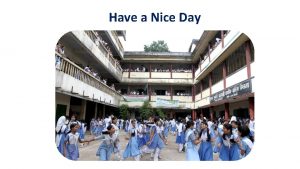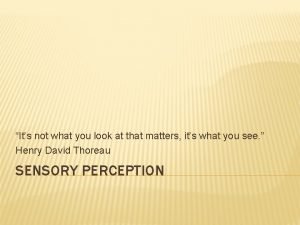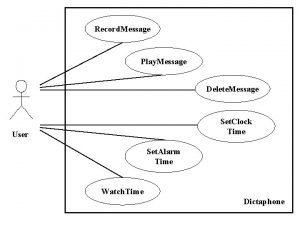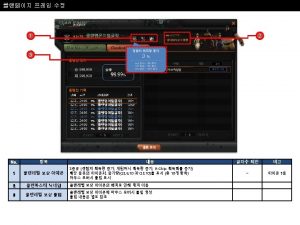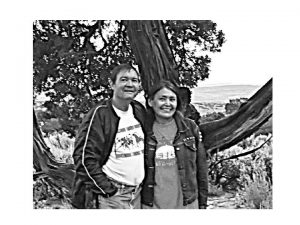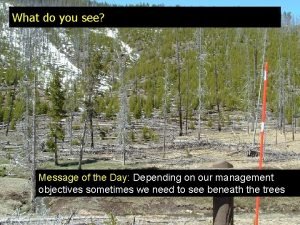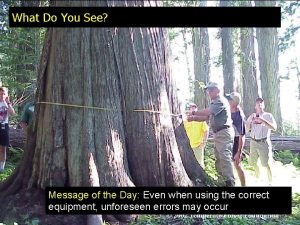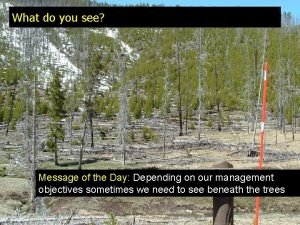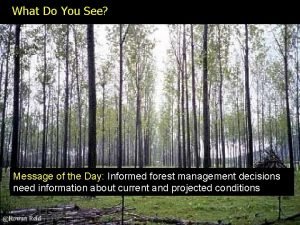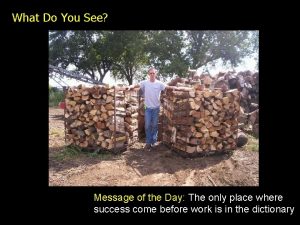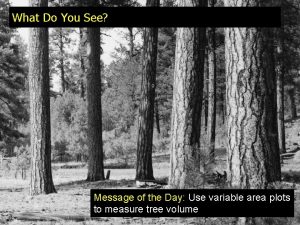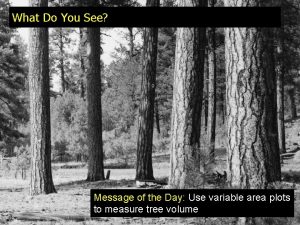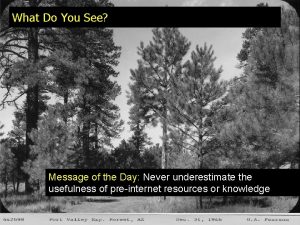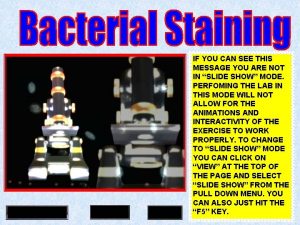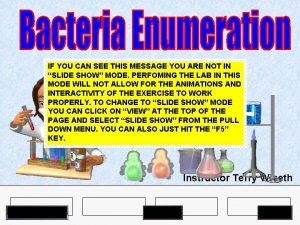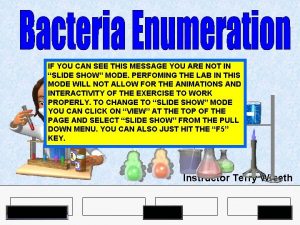What Do You See Message of the Day













































- Slides: 45

What Do You See? Message of the Day: Identification of tree defects prior to harvest can save you time and money

FOR 274: Defects • Prominent Features • Rots, Borers • Stem Rusts and Cankers • Wounds • Animal Damage and Insects • Log Grading For More Information: FOR 468: Forest and Plant Pathology PS&ES: Forest Entomology and Insect Ecology

Defects: Introduction Assessment of defects in standing timber are highly site specific and typically covered during on the job training. • Defects result in timber loss; some minor, some complete. • Afflicted trees and logs need to be examined in order to adjust output predictions accordingly. • More Damage = Less Products • A system common to both buyer and seller must be used. Source: Partridge et al. A handbook of defect estimators for standing timber, USFS

Defects: Introduction It is common to classify deductions made for defects into hidden and visible. Hidden Defects: Lack external indicators Visible Defects: Based on visual evidence (and not hunches!) The main sources of visible defects are from natural defects (rots, insects, etc) and from mechanical / logging damage. Natural defects exist within the tree before it is felled. Mechanical defects can occur during logging, felling, and processing. USDA FS Region 6 Cruising Manual

Defects: Introduction Visible abnormalities that inform us of potential defects are called defect indicators. Common defect indicators include: Ø Butt swell Ø Sap rot Ø Conks Ø Crooks Ø Bark Seams Ø Catface Ø Broken Tops Ø Sucker Limbs Ø Fire Scare Ø Insect Damage Ø Sweep Ø Forks USDA FS Region 6 Cruising Manual

Defect Indicators: Prominent Features Swelling: A swelling is a bulge, mound, lump, or knob typically found under the bark Rusts only occur on live trees. Depressions: Examples include cankers, which are sunken areas on the stems Western Gall Rust Cankers are defined as “expanding patches of dead or dying bark and cambium” Atropellis Canker

Defect Indicators: Prominent Features Wound or Scars: Can be the result of mechanical damage or falling trees, such as broken or snapped-off branches. Lightning and fires can also cause scars Cracks or Splits: Examples can include splits caused by rapidly changing temperatures

Defect Indicators: Prominent Features Holes and Cavities: Insects and birds can leave behind holes on the stems. Frequently Wood Chips can be found at the base of affected trees. Fungus Parts: It is common to find signs of fungus such as conks, mushrooms, and toadstools.

Defect Indicators: Prominent Features Frass: This is fine powdering material that insects leave as waste after digesting plants. It also can refer to excavated wood shavings that ants and other borers (that do no eat the wood) remove as part of mining Pitch: Excessive amounts of pitch present with frass is a good indicator of insects Sweep or Crooks: This is when the stem is not straight

Defect Indicators: Prominent Features Broken Tops and Bases: When broken tops are present without decay, only the broken area +2’ below is culled. Various rots will often be present in these tops and bases. Bark Eaten or Ripped: Bears, deer, and elk commonly scratch or rip bark from stems. Generally these do not remove wood volume unless the tree does not heal.

Defect Indicators: Prominent Features Brooms: Often associated with mistletoe.

Defects: Root Rots Different types of rots can be identified by several visual indicators. Root rots kill fine roots in trees often resulting in wind thrown trees. In the Pacific Northwest, common root rots include: - Laminated root rot (Phellinius weirii & Porta werii) - Shoestring rot (Armillaria ostoyae) - White spongy rot (Fomes annosus)

Defects: Butt and Sap Rots Butt rots occur near the tree base, often resulting in butt swell. The volume loss in these trees are usually limited to the base of the butt log. Sap rots affect the outer edge of the tree stems. Snags are common hosts. In the Pacific Northwest, common sap rots include: - Purple conk (Polyporus volvatrus)

Defects: Butt and Heart Rots Heart rots affect the tree’s heartwood. Generally the size of the conks are a good indicator of the degree of damage. In the Pacific Northwest, common heart rots include: - White speck (Phellinus pini) - Indian paint conk (Echinodontium tinctorium) - Light brown cubical rot (Fomitopsis cajenderi)

Defects: Rots – Some Local Suspects Red Ring Rot Caused by Phellinus pini Targets larch and white pine What to Look For: Conks: 1 -12” across, hard to touch, conks are layered and usually yellowbrown color Defect: • Single conks on larch indicate total heartwood loss • Multiple conks usually indicate total heartwood cull. • Single conks on non larch are culled 24 feet up and 4 -5 feet down from conks Red Ring Rot

Defects: Rots – Some Local Suspects Fibrous White Rot and Stem Rot Caused by Armillaria mellea Targets planted trees What to Look For: Fungus: white fans appears under bark at tree bases Rhizomoprhs: black fungus appears in and on the roots Mushrooms: light brown/honey color around tree bases in late fall Defect: • Generally decay extends upwards from base up to 5 feet Fibrous White Rot

Defects: Rots – Some Local Suspects Stringy Heart Rot Caused by Echinodontium tinctorium Targets hemlock and grand fir – major source of hardwood decay of true firs in the Northwest What to Look For: Hollow Trunks and decayed heartwood: fibrous, yellow, and circular Conks: large and hard below branches. Dark colored with bright red interior Knots: containing bright-red fungus Defect: • Single conk equates to 16 -50 feet of heartwood loss. Stringy Heart Rot

Defects: Rots – Some Local Suspects Red-Brown Root and Butt-Rot Caused by Phaeolus schweinitzii Targets Douglas fir and pines What to Look For: Conks: rare on trees, if present: on duff beneath the trees. These area 618” and are dark brown. Increment bore: use at DBH Defect: • Single conk on or near the tree indicates 8 -12 feet of tapered decay in the first log. • Ants or dry habitats can cause decay to extend to above 32 feet. Red-Brown Root

Defects: Borers – Some Local Suspects Ponderous Borer Caused by Ergates spiculatas Targets standing dead Douglas fir and ponderosa pine What to Look For: Frass packed tunnels: observed in penetrated wood Defect: • Usually localized to lowest part of 1 st log. Ponderous Borer

Defects: Borers – Some Local Suspects Carpenter Ants – Campanotus spp. Targets conifer and hardwood heartwood in live trees What to Look For: Boring dust: dust piles appear below holes at the base of trees Tunnels: These are vertical and can be up to 1 cm wide and several feet long. Decay: These insects are usually associated with decay Defect: • frass indicates heavy damage and loss extended 10 -32 feet up tree. Carpenter Ants

Defects: Rusts and Cankers – Some Local Suspects Western Gall Rust Caused by Endocronartium harknessii Targets most 2 and 3 needles pines, including ponderosa, Scots, lodgepole What to Look For: Galls: Large galls form on stems and branches Orange spores masses: In spring these appear from the living galls Dead branches: Broken bark leads to branch and gall death Defect: • 3 feet in each direction of gall Western Gall Rust

Defects: Rusts and Cankers – Some Local Suspects White Pine Blister Rust Caused by Cronartium ribicola Targets most 5 needle pines, including white, limber, whitebark, etc What to Look For: Cankers: Old cankers will exhibit many cracks and swelling will be present above cankers Dead branches: Yellow to red-brown foliage will be common when branches above cankers are killed Bark discoloration: in spring, blisters appear as small (1 -3 mm) yellow to light-brown patched. Once dried, the dark lesions are visible all year round. White Pine Blister Rust

Defects: Rusts and Cankers – Some Local Suspects White Pine Blister Rust Caused by Cronartium ribicola Targets most 5 needle pines, including white, limber, whitebark, etc What to Look For: Blisters: within the lesions, white blisters appear that contain powdery, orange-yellow spores. Blisters will develop each year until the stem above a canker is killed. Defect: • Only cull killed tops and branches White Pine Blister Rust

Defects: Rusts and Cankers – Some Local Suspects Atropellis Cankers Caused by Atropellis spp. Only affects pines What to Look For: Cankers: Perennial – the wood beneath each canker is streaked blue -black or grey-green Fungi: black discs appear on bark of cankered areas Defect: • Common to use a 15% deduction for logs with canker Atropellis Canker

Defects: Wounds Mechanical Wounds: Defects usually limited to the wound area unless there are other signs of decay Sweep or Crook: Stem is usually divided up into as many useable sections as possible.

Defects: Animal Damage No defect: Damage resulting from bears, elk and sapsuckers generally do not result in any cull Woodpecker Damage: Presence of woodpecker holes generally indicate that insect borers and heartwood loss is present

Defects: Bark Beetles and Stem Insects Mountain Pine Beetle Dendroctonus ponderosae Affects lodgepole pine, ponderosa pine, western white pine, whitebark pine, and limber pine What to Look For: White pitch tubes: seen in the lower stem with red boring dust present Red attack: Foliage rapidly turns red Defect: • Sapwood to a depth of 10” will be heavily stained. • No defect except eventual tree mortality

Defects: Bark Beetles and Stem Insects Western Pine Beetle Dendroctonus brevicomis Affects lodgepole pine, ponderosa pine, and western white pine What to Look For: White pitch tubes: seen in the lower stem with red boring dust present Galleries: Maze-like and crisscrossing Defect: • Sapwood to a depth of 10” will be heavily stained.

Defects: Bark Beetles and Stem Insects Pine and Spruce Engravers Ips spp. Affects pines and spruces What to Look For: Change in color: tree turn grey-green and then yellow, followed by light brown Galleries: Egg galleries radiate from a central chamber Defect: • Tree mortality • Sapwood is often stained blue leading to loss in value

Log Valuation: Grading Understanding the value of logs derived from a tree informs landowners and log buyers of the fair price for the timber Main factors that determine the value of a log: Species, Scale, and Grade is a measure of the quality of the log and the products that can be derived. Grade is usually inferred by how much defect free wood is present in the 1 st log. The butt log will usually contain the highest percentage of clear wood (non defect). Grade can be assigned on standing timber during cruising (each log per tree done independently) or once the trees are felled.

Log Valuation: Grading Definitions Scaling Cylinder: cylinder within log with diameter equal to DIB at small-end Surface Clear (clear-cuts): portion of log’s surface area free of grading defects Worm Holes: Pin (<1/16” dia), Small (<1/4” dia), Large (>1/4” dia) Knots: Pin (<1/2” dia), Small (1/2 -3/4” dia), Medium (3/4 – 1 ½” in dia) Large (>1 ½ ” dia)

Defecting Standing Timber: The Cubic Approach In the cubic approach each sawlog can have up to 60% defect. Non-sawlogs products are cruised for gross volume with no deductions made USDA FS Region 6 Cruising Manual

Defecting Standing Timber: The Scribner Approach In the Scribner approach each sawlog can have up to 66% defect. Non-sawlogs products are cruised for gross volume with no deductions made USDA FS Region 6 Cruising Manual

Defecting Standing Timber: Trunk Injuries When dealing with fire scars, basal, and trunk injuries deductions are only made if there is volume loss. Scribner defects are only counted if the defect penetrates the scaling cylinder. USDA FS Region 6 Cruising Manual

Defecting Standing Timber: Trunk Injuries Lightning scars will cause defects using both the cubic and Scribner methods. USDA FS Region 6 Cruising Manual

Defecting Standing Timber: Crooks and Sweeps USDA FS Region 6 Cruising Manual

Log Valuation: Grading Component of a Grade: Tree / Log Size: Specific products require minimum log diameters and length Scaling Diameter: 80% DBH (where form class / top 1 st log DIB is not known) Grading Faces: Butt log is divided into 4 sections – attempt to have majority of defect in one face (the worst face). 2 nd worst face is usually “tree grade” Generally, faces are graded by the lengths that products can be obtained. Worst 2 nd 3 rd 1 st

Log Valuation: Softwood Log Grading Veneer class (High and some low quality logs that can be utilized) Sawlog class (logs adapted for the production of yard and structural timber) Count number of clear faces: (rotate log such that the majority of the defects are in one face) Grade 1: logs with 3 -4 clear faces Grade 2: logs with 1 -2 clear faces Grade 3: logs with no clear faces Next, reduce the log by “ 1 grade” for each instance of: Sweep: ≥ 3” and ≥ 1/3 rd log scaling diameter Heartrot: if evidence of advanced rot present

Log Valuation: Hardwood Log Grading Veneer class (Highest quality) Factory class (Lumber quality) - The USDA FS usually divide them into 3 grades: F 1, F 2, and F 3 (table below). Low quality logs have two classes: construction class (where appearance is not a concern) and local-use class for use in pallets and in products where standards are not required. Straightness (i. e. presence of sweeps) and taper also affect grade

Log Valuation: F 1 Grade

Log Valuation: F 2 Grade

Log Valuation: F 3 Grade DIB = 8”

Log Valuation: Features that Reduce Quality Twist (Spiral Grain): Some trees spiral around their central axis causing the grain to spiral. This reduces wood strength and in excessive cases causes the wood to not be merchantable. Insect and Worm Holes: In some regions, there are limits on the number of insect holes that can be present within certain grades. Sound Stain: Stain that has not become a deductible rot is a grade defect

Log Valuation: Features that Reduce Quality Size, number, and location of knots: Generally knots larger than 1” will reduce lumber quality as the grain will deflect around the knot. Knots are generally described as sound or rotten; and tight or loose. Sound and tight knots produce higher quality lumber than rotten and loose knots. Rotten knots occur where fungus spores enter a broken or dead branch or where decay is internal. Tight knots occur when the branches were still green at the time of harvest.

Log Valuation: Example Grades No. 1 Peeler Douglas Fir minimums: Gross Diameter: > 30 inches Gross length: > 17 feet Surface: 90% clear Knots: maximum 2 per log Annual ring count: 8 per inch Slope of grain: < 3 inches per foot No. 2 Peeler Douglas Fir minimums: Gross Diameter: > 30 inches Gross length: > 17 feet Surface: 75% clear Knots: maximum 2 per log Annual ring count: 8 per inch Slope of grain: < 3 inches per foot No. 3 Peeler Douglas Fir minimums: Gross Diameter: > 24 inches Gross length: > 17 feet Surface: Limited to knot indicators < 1 ½” in diameter Knots: maximum 1 per foot of log length Annual ring count: 6 per inch Slope of grain: < 3 inches per foot
 Day 1 day 2 day 3 day 4
Day 1 day 2 day 3 day 4 Day 1 day 2 day 817
Day 1 day 2 day 817 See you again have a nice day
See you again have a nice day It's not what you look at that matters, it's what you see.
It's not what you look at that matters, it's what you see. If you could see the future what would you do
If you could see the future what would you do Good morning good morning to you i am glad to see you
Good morning good morning to you i am glad to see you Tardes buenas tardes
Tardes buenas tardes Rapporteren voorbeeld
Rapporteren voorbeeld It was such a foggy day that we couldn't see the road
It was such a foggy day that we couldn't see the road Count that day lost poem
Count that day lost poem Count that day lost by george eliot
Count that day lost by george eliot William beanes elementary
William beanes elementary Oceans apart day after day meaning
Oceans apart day after day meaning Day to day maintenance
Day to day maintenance As your room gets messier day by day, entropy is
As your room gets messier day by day, entropy is I don't know tomorrow
I don't know tomorrow Romeo and juliet day timeline
Romeo and juliet day timeline Growing day by day
Growing day by day Observation of seed germination day by day
Observation of seed germination day by day Conclusion of seed germination
Conclusion of seed germination Observation of plant growth day by day
Observation of plant growth day by day I live for jesus day after day
I live for jesus day after day Casting crowns one day
Casting crowns one day Day one day one noodle ss2
Day one day one noodle ss2 Dayone dayone noodles ss2 小時光 肆號麵鋪
Dayone dayone noodles ss2 小時光 肆號麵鋪 Hình ảnh bộ gõ cơ thể búng tay
Hình ảnh bộ gõ cơ thể búng tay Ng-html
Ng-html Bổ thể
Bổ thể Tỉ lệ cơ thể trẻ em
Tỉ lệ cơ thể trẻ em Gấu đi như thế nào
Gấu đi như thế nào Glasgow thang điểm
Glasgow thang điểm Chúa yêu trần thế alleluia
Chúa yêu trần thế alleluia Các môn thể thao bắt đầu bằng từ đua
Các môn thể thao bắt đầu bằng từ đua Thế nào là hệ số cao nhất
Thế nào là hệ số cao nhất Các châu lục và đại dương trên thế giới
Các châu lục và đại dương trên thế giới Công thức tính độ biến thiên đông lượng
Công thức tính độ biến thiên đông lượng Trời xanh đây là của chúng ta thể thơ
Trời xanh đây là của chúng ta thể thơ Mật thư anh em như thể tay chân
Mật thư anh em như thể tay chân Phép trừ bù
Phép trừ bù Phản ứng thế ankan
Phản ứng thế ankan Các châu lục và đại dương trên thế giới
Các châu lục và đại dương trên thế giới Thơ thất ngôn tứ tuyệt đường luật
Thơ thất ngôn tứ tuyệt đường luật Quá trình desamine hóa có thể tạo ra
Quá trình desamine hóa có thể tạo ra Một số thể thơ truyền thống
Một số thể thơ truyền thống Cái miệng nó xinh thế chỉ nói điều hay thôi
Cái miệng nó xinh thế chỉ nói điều hay thôi Vẽ hình chiếu vuông góc của vật thể sau
Vẽ hình chiếu vuông góc của vật thể sau


